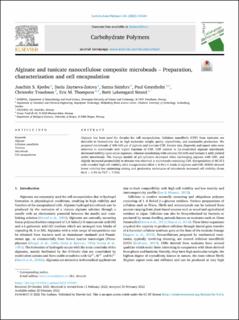Alginate and tunicate nanocellulose composite microbeads – Preparation, characterization and cell encapsulation
Kjesbu, Joachim Sebastian; Zaitseva-Zotova, Daria; Sämfors, Sanna; Gatenholm, Paul; Troedsson, Christofer; Thompson, Eric Malcolm; Strand, Berit Løkensgard
Journal article, Peer reviewed
Published version

Åpne
Permanent lenke
https://hdl.handle.net/11250/2996267Utgivelsesdato
2022Metadata
Vis full innførselSamlinger
- Department of Biological Sciences [2235]
- Registrations from Cristin [9791]
Sammendrag
Alginate has been used for decades for cell encapsulation. Cellulose nanofibrils (CNF) from tunicates are desirable in biomedicine due to high molecular weight, purity, crystallinity, and sustainable production. We prepared microbeads of 400–600 μm of alginate and tunicate CNF. Greater size, dispersity and aspect ratio were observed in microbeads with higher fractions of CNF. CNF content in Ca-crosslinked alginate microbeads decreased stability upon saline exposure, whereas crosslinking with calcium (50 mM) and barium (1 mM) yielded stable microbeads. The Young's moduli of gel cylinders decreased when exchanging alginate with CNF, and slightly increased permeability to dextran was observed in microbeads containing CNF. Encapsulation of MC3T3 cells revealed high cell viability after encapsulation (83.6 ± 0.4%) in beads of alginate and CNF. NHDFs showed lower viability but optimizing mixing and production techniques of microbeads increased cell viability (from 66.2 ± 5.3% to 72.7 ± 7.5%).
